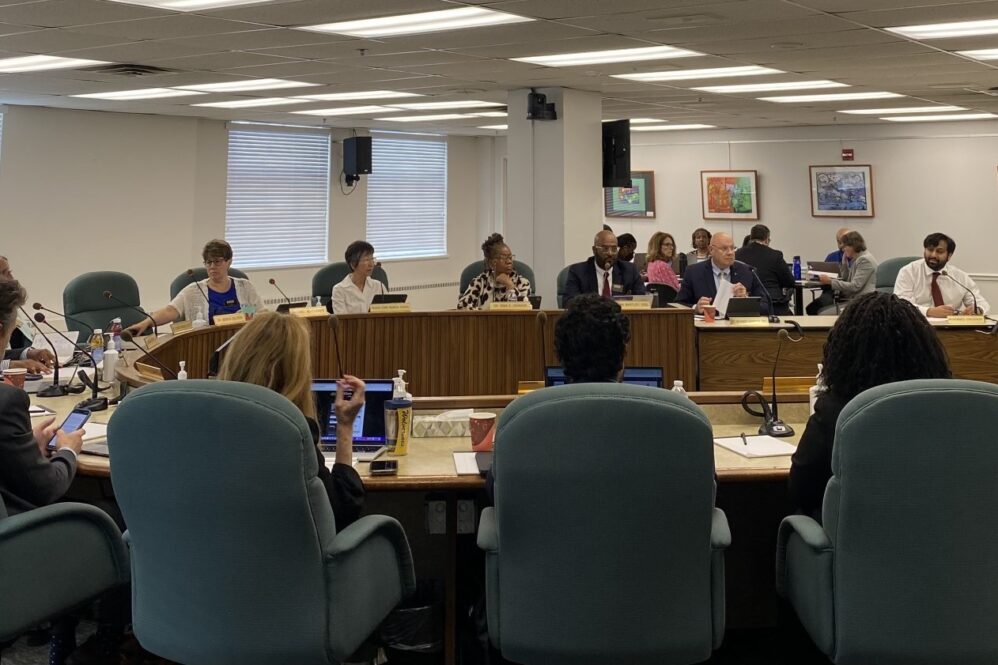MARYLAND MATTERS: An analysis of Maryland’s current “college readiness” metrics meant to determine whether high school students are properly prepared for college may be improperly assessing a large percentage of students, according to a new report analyzing the state’s interim College and Career Readiness standards.
In fact, as much as 35% to 53% may be inaccurately assessed as either ready for college or not ready for college, the American Institutes for Research’s report to the Maryland State Department of Education found.
The College and Career Readiness (CCR) standard is a central goal for the Blueprint for Maryland’s Future, an education overhaul passed by the 2021 Maryland General Assembly, in order to determine if students are properly prepared to take on a 2-year or 4-year postsecondary education, and then ultimately enter the workforce.
In 2022, the Maryland Board of Education set up interim CCR standards to lay the groundwork for more-permanent standards down the line. Students are currently evaluated as “college ready” if they surpass benchmarks in 10th grade English and benchmarks in one of the following math courses: algebra 1, algebra 2, or geometry. Students can also earn a score of 520 on the SAT math test to prove college readiness under the interim standards.
The Blueprint also required MSDE to contract with a public or private entity to help evaluate the interim standards and offer suggestions for how they could be improved.
And there appears to be room for improvement, according to the American Institutes for Research (AIR), which is a nonpartisan, not-for-profit research facility that was tasked with conducting the analysis. The final report was released on Sept. 14 and the Board of Education discussed the findings at a meeting this week.
“AIR completed a multifaceted, best-in-class investigation into the predictors of postsecondary success and the alignment of high school standards to postsecondary expectations,” State Superintendent of Schools Mohammed Choudhury, said in a written statement in mid-September. “The study is full of crucial insights into ensuring that Maryland sets a CCR standard that is aligned with national research and ensures equitable access for all students.”
In the coming months, education officials and leaders will be using the study in order to create and approve a new CCR standard.
“To assess the quality of different high school measures of CCR, we examined how well the interim CCR standard and alternative definitions of the standard predicted students’ progress toward postsecondary success, particularly college course credits earned in a student’s first semester in college,” the report said.
One of the caveats for the analysis is that it was conducted on students in graduating classes from 2017 to 2021, and the results “may not apply to future student cohorts,” according to the report. The analysis also did not look at the Maryland Comprehensive Assessment Program (MCAP) because the assessment was too new at the time of the study.
That said, one of the main takeaways from the report is that the current interim CCR standards often misclassifies students on their readiness.
For example, the analysis says that only 35% of the students in the study were “correctly classified” as ready for college under the interim CCR standards, based on whether a student earned math credit in their first year of post-secondary education. But 5% we’re “misclassified” as ready, as they struggled to earn a math credit in their first year.
Meanwhile, the analysis shows that the current interim standards correctly classified 28% of students as not college ready, but misidentified 32% of students as “not college ready,” when in fact they were able to earn a math credit in their first year.
“So they did not meet CCR standard, but they demonstrated they could earn math credit when they enter college,” Jordan Rickles, the principal researcher for the study, explained to the Board of Education Tuesday. “So this is the big source of error when it comes to the validity of our standard. For almost a third of students, the standards say they’re not college ready, but we have evidence that when they really go off to college, they really can do well in these first year courses.”
The AIR analysis says that the interim standard has an accuracy rate between 47% and 65%, depending on subject matter measured.
To further complicate the analysis, the interim standards were even less accurate for certain demographics, such as for Black students, Hispanic students, current English learners, students with disabilities, and students eligible for free and reduced price meal services. For these populations, the interim CCR standard had average accuracy rates that were less than 60%, the report says.
The analysis looks at potential alternatives for how the state can identify which students are ready for college and which ones could use some additional help. The board will also be looking at the college readiness standards of other states to help inform their future decisions.
The analysis puts forward that it may be more accurate to analyze college readiness through a high school Grade Point Average threshold or the interim CCR standards, meaning that a student could meet either benchmark in order to be deemed college ready.
If the board were to take up that alternate college readiness metric, then the accuracy rate is expected to increase to about 75%, meaning that three in four students would be accurately evaluated as college ready or not.
The analysis suggests that a high school GPA threshold between 2.83 and 2.98 would be a strong indicator of a student’s college readiness, but the AIR recommends rounding up to a 3.0.
The report also advises the department to revise CCR standards to assess more accurately and equitably. That includes providing students with two options to meet CCR standards, either based on state assessments or through a GPA of at least 3.0. If the department takes this route, the MSDE would need to work with local education agencies to better standardize and align grading practices across Maryland.
AIR also recommended that the department help students strengthen college readiness by providing additional counseling and other wrap-around services in middle and fhigh school that cultivate skills and knowledge critical for college success. Such skills include critical thinking, self-direction, and other skills that are not part of formal high school standards.










